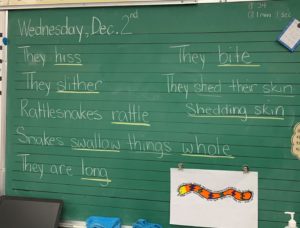Educators understand and apply knowledge of student growth and development.
During my 4 week practicum I wanted to create a mini-unit on poetry. This idea stemmed from our school requirement of creating sets of 3 linked lessons. As my first degree was a BA in English, I was very eager to bring my love for this subject into my practicum! When I began creating these lessons I first thought about how I could introduce poetry in a fun way that allowed for students to personally connect with their work. I decided that after this initial, more broad learning, that I could continue to develop my class’ understanding of the subject and progressively challenge them. The first form of poetry I chose to teach them was Acrostic. This lesson centered on the understanding of what an Acrostic poem is, and then invited students to create their own using their name. Through frontloading processes I shared with them the steps they needed to complete such a poem. Following this lesson, I introduced them to Haiku poetry. Haiku poems follow a strict format in their creation and focuses on the use of syllables. I specifically chose Haikus because it helped introduce my students to the concept of poems having structures and formatting to follow, but it also is short enough in length that creating their own would be less daunting and overwhelming. My lesson on Haikus centered heavily on scaffolding. I did this so as to support my students throughout their learning and help them to develop their understandings as much as possible before asking them to write their own. This scaffolding approach I used can be seen in the lesson plan attached. Finally, to conclude my mini-unit on poetry, I taught my students about Shape poems, also known as Concrete poems. I chose this type of poem as it, again, allows for student choice. Students were able to choose whatever shape they wanted, as long as they knew a good amount of information about it and could successfully draw it, to create their poem on. For this lesson I also used a scaffolding approach. To begin we created a shape poem together on snakes, and brainstormed words and phrases that described a snake. After our creation, I invited students to use a web template to decide on a topic and then brainstorm words and phrases to describe this. Next, I decided that as a class we should go over how we can change our long sentences into short phrases (ex. The sun shines light on the earth, to Shining light on earth). I decided to add this extension of learning after reading over my students’ initial work thus far and noticing that they needed some extra guidance in this area. In doing this, students were given the opportunity to grow their learning and edit and revise their works. Overall, this mini-unit on poetry went very well. I was so glad to see the progress made throughout each style of poem and was blown away by my students’ growing understandings of poetry!


You can find my lesson plans for Acrostic, Haiku, and Shape Poems here:
Lesson Plan – Acrostic Poem
Lesson Plan – Haiku
Lesson Plan – Shape Poem